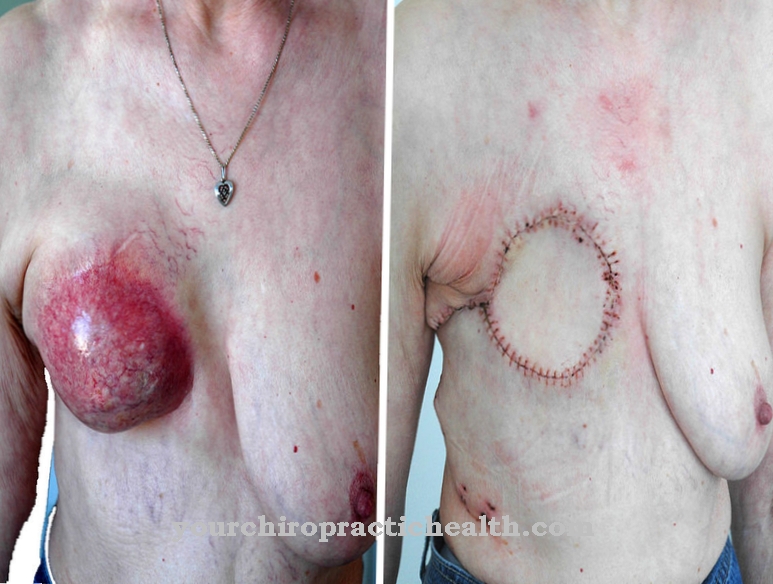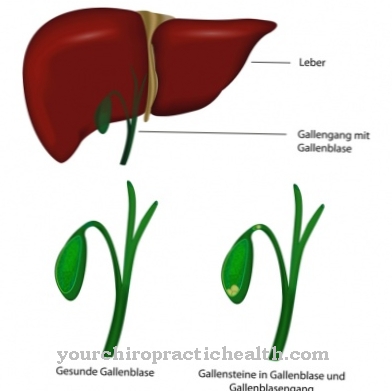A not inconsiderable number of people suffer from them, but most of them are definitely afraid of them. After all, who wants to have limited eyesight or, in the worst case, even lose it completely? But the knowledge about the diseases is mostly limited at most to general places. For this reason, the aim of this article is to shed some light on the darkness and to provide information about the diseases and visual defects that exist. What symptoms do they show, how do they proceed? Which of them can you take action against and which not? In addition to the diseases, the article deals with the widespread visual impairments such as myopia and farsightedness and other visual disorders such as color blindness.
Myopia and farsightedness

Let's start with the less severe eye impairments. Visual defects can also cause various complaints in everyday life. The first to be mentioned here is myopia or farsightedness. Myopia or hyperopia cannot in itself cause blindness and should therefore be viewed calmly for the time being. Since the difficulty in recognizing distant or close objects - depending on the type of ametropia - can have an impact on everyday life, you should consult aids that regulate everyday requirements depending on the severity of the weakness.
For a long time glasses were considered unfashionable, but these days are rightly over. Instead, many people understand the visual aid as a chic accessory. Specialist shops offer a large selection of different glasses frames and can also help with individual advice. New models are always coming onto the market to match the current fashion. If you still cannot put up with glasses, you can of course still use contact lenses or even have your eyes lasered.
Basically, a semi-regular visit to the specialist is of course necessary in order to observe the further development of the visual impairment and to be able to take appropriate countermeasures in the event of the problem.
Color blindness
Similar to nearsightedness and farsightedness, this is not a disease, but a visual disorder, as the name suggests. Strictly speaking, there are not only color-blind people, but also those who only have a weakness in color perception. Of course, color-blind people have to accept immense impairment of their everyday life.
Much more common than the actual color blindness is actually the red-green weakness, which, depending on the information, affects between five and nine percent of the male German population. It is only difficult to perceive the two colors because the rods for perceiving the corresponding colors are missing. Incidentally, the red-green weakness is much more common in men than in women. This is because the corresponding genes for color perception are on the X chromosome, of which women are known to have two, while men only have one.
True color blindness, however, means not being able to perceive any colors and only perceiving the environment in different shades of gray. In this way, for example, participation in traffic can be made considerably more difficult. Apart from gene therapy, which has not yet been adequately researched, there is still no healing method.
Inflammation of the eye

Eye infections are relatively common and have a wide variety of causes. Even if we barely register it: the eye is busy all day defending itself against all kinds of environmental stimuli and pathogens. Inflammations in the eye are often nothing more than reactions to bacteria and viruses by the immune system. Of course, it must be taken into account that environmental influences such as smoke, drafts or bright sunlight do not necessarily make it easier for the eyes to protect themselves.
Symptoms of eye infections
Although there are very different inflammations in the eye, the symptoms are quite often similar. What they all have in common is that they are extremely annoying and can be both painful and hindering - of course, because they hinder a not unimportant part of your own perception. Typical symptoms can be, for example:
- The affected eye secretes a secretion
- Shooting pain in the affected eye
- Red eye
- Swelling of the affected eye
- Increased sensitivity to light
- Heavily veiled vision
The conjunctivitis

Of course, there are different types of inflammation caused by the complexity of the eye that can occur in different places. Conjunctivitis, also known as conjunctivitis, is one of the classic inflammations that can occur in the eye. In addition to the factors already mentioned, an allergy can also cause conjunctivitis.
But what is a conjunctiva anyway? The conjunctiva is ultimately a mucous membrane that is at home in the anterior segment of the eye and is therefore felt in the eye socket. Incidentally, it is not only considered during ophthalmological examinations, but also during clinical examinations in general. Because it is relatively thin, has a good blood supply and is unpigmented, it is relatively easy to detect changes in the blood. In the complex structure of the eye, it has a special task: It is very important, among other things, because it distributes the tear fluid over the cornea.
If the conjunctiva is inflamed, one often has the feeling that there is a grain of sand in the eye. So you feel as if you had a foreign body in your eye, even if, from a purely objective point of view, this is of course not the case.
However, there are different types of conjunctivitis that must be distinguished between. There are, for example, allergic, bacterial and viral conjunctivitis, but also non-specific conjunctivitis. We briefly show the different symptoms here.
Symptoms of allergic conjunctivitis
Sudden and unexpected tears and very itchy eyes dominate the symptoms of allergic conjunctivitis. The swelling of the eyelids can also cause them to sag slightly as a result.
Symptoms of bacterial conjunctivitis
In addition to the usual consequences of conjunctivitis in the bacterial variant, the fact that a lot of mucus forms in the corners of the eyes is particularly unpleasant.The eyes are regularly gummy, especially in the morning. The problem here is that bacterial conjunctivitis often occurs in both eyes because it is contagious.
Symptoms of viral conjunctivitis
The viral conjunctivitis often does not occur alone, but is often a consequence of the diseases transmitted by the virus. In the case of flu, measles and chickenpox, for example, the pathogens then spread to the conjunctiva and thus further torment those who are already sick.
Diagnosis and treatment
Conjunctivitis is usually diagnosed by an ophthalmologist. He looks at the eye with a so-called slit lamp and folds the eyelid over to see the inside of the eyelids. A smear test may be necessary to determine the causes of the inflammation and thus the correct treatment method.
Depending on the situation, the ophthalmologist will then, for example, prescribe an appropriate antibiotic or an eye ointment. Certain eye drops are also conceivable, with some conjunctivitis healing on their own. As a layperson can never be sure about this and the conjunctivitis can be potentially contagious, you should definitely consult an expert.
Corneal inflammation (keratitis)
There are also different variants of corneal inflammation, which is technically called keratitis. Again there is bacterial and viral keratitis, as well as one caused by fungi. The cornea is particularly vulnerable if it has already been damaged. A healthy cornea is usually relatively stable and has a corresponding defense. What is particularly dangerous about corneal inflammation is that the associated infection can spread to other, surrounding parts of the eye and also damage them. For this reason, if the corneal inflammation is not treated, serious consequences may arise.
One of the most common causes of corneal inflammation is wearing contact lenses for too long - or if they are not cleaned. However, it depends a lot on the type of contact lenses. The symptoms are very similar to those of conjunctivitis: pain, reddened and sticky eyes and poor eyesight are among the symptoms.
Again, one should follow the warning signs of symptoms and see an ophthalmologist. Treatment as quickly as possible is absolutely essential. The diagnostic procedures are very similar to those for conjunctivitis: First, the doctor must know about the cause of the inflammation. The way the inflammation is medicated is also quite similar.
However, if the cornea is inflamed, surgery can be necessary, for example if it is the variant caused by fungi and the deeper layers of the cornea are already affected. It is precisely for this reason that you should seek treatment at an early stage. If this is the case, the corneal inflammation can usually be cured relatively quickly.
The glaucoma - glaucoma

The glaucoma is the collective term for a whole range of eye diseases which most sufferers do not appear until they are 40 years of age (unless they are congenital) and in the worst case can lead to complete blindness. As with the eye diseases presented so far, it is important to act in good time.
But how does glaucoma develop? As a rule, the development of glaucoma is accompanied by increased pressure in the eyeball. This occurs when there is more aqueous humor in the anterior chamber of the eye (the area in which the lens of the eye is located) than can be drained away via the eye's drainage system. As a result, the aqueous humor in the eye is not exchanged often enough. The aqueous humor is so important because it acts as a nutrient supplier for the lens and the cornea, both of which have no blood vessels of their own and for this reason are dependent on the aqueous humor as a nutrient supplier. The aqueous humor also serves as an optical medium. If it builds up and can no longer be replaced properly, the pressure in the eye increases.
The problem caused by the increased pressure should not be underestimated. Because the supply of blood and thus also urgently needed nutrients is neglected in the eye. This leads to typical restrictions in the field of vision. If you take notice of this, you should look at it with the necessary seriousness and definitely react by visiting a specialist.
Shockingly, the glaucoma is still one of the most common causes of blindness. Unfortunately, two thirds of those affected notice that they are ill much too late. In total, there are 800,000 people who suffer from glaucoma on average.
Glaucoma symptoms
This is why it is so important to understand your glaucoma symptoms in order to respond to them. As already mentioned, narrowing of the visual field is very common. This narrowing occurs regularly in an arcuate manner that should give cause for alarm. Other deteriorations in vision are also conceivable, such as a loss of visual acuity and contrast. If the increased intraocular pressure has existed for a long time, there is a high probability that edema in the eye will lead to light refractions that can be seen as colored rings or halos when looking into brighter light sources.
General symptoms in the event of a glaucoma attack include severe headache, nausea and vomiting, as well as cardiac arrhythmias and collapse.
Treatment for glaucoma
In any case, the green star needs medical treatment. This can be done with both medication and surgical measures, depending on the situation. It depends entirely on the form of glaucoma and the causes behind the disease, which measures can lead to success.
Scotoma - failure of the visual field

Another extremely unpleasant variant of the eye disease is suffering from a so-called scotoma. This word describes the phenomenon when the eyesight in a certain area of the field of vision deteriorates or even fails completely. It is noteworthy that this can occur both in the central viewing area and in the edge areas. It is the case that the failure is noticeable subjectively. In the worst case, the loss of vision can even lead to partial blindness.
Various factors can be responsible for this failure or the reduction. It is difficult to locate the causes properly. Because diseases in every imaginable section of the visual pathway can be responsible for the reduction, but other diseases could also be possible triggers.
There is a distinction between different forms, which we would like to briefly introduce here:
- Relative scotoma:The visual impression is indistinct, shadowy and a clear recognition is difficult.
- Absolute scotoma: Complete loss of the ability to see anything in the area of the scotoma.
- Distortion: The objects in the corresponding area are only perceived as distorted.
- Homonymous visual field loss: Unilateral visual field loss on the same side in both eyes. There is also heteronymous visual field loss where the sides are different.
- Hemianopia: Half-sided visual field loss
A specialist examination of the phenomenon is especially necessary if the scotoma meets some requirements. For example, if there are accompanying symptoms such as vomiting, nausea, speech disorders or disorientation, flashes of light, flickering or similar symptoms, you should definitely seek medical help.
Age-related macular degeneration

Macular degeneration, i.e. the degeneration of the retina in the back of the eye, is a disease that can occur in general, but mainly and by far most common in older people. In the general course of the disease, there is an increasing loss of vision in the central visual field, while the peripheral visual field remains unaffected.
The numbers for those affected are definitely worth mentioning: a total of around three million people in Germany are affected by age-related macular degeneration. It is therefore the most common cause of blindness. There are basically two different types of age-related macular degeneration: on the one hand the dry variant and on the other hand the moist.
Let's start with the dry one, which is also the far more common variant. The loss of vision due to the loss of visual cells takes place here step by step. In the beginning, the eyesight is only relatively slightly impaired, but the limitations become more and more noticeable over time.
The wet variant, on the other hand, usually develops from the dry one, but runs much faster. It is also irreversible and causes permanent vision loss that is more difficult to stop than that of dry macular degeneration.
Unfortunately, there is still no fundamental cure for the disease. However, it is possible to slow down or stop the progression of the disease. Here, too, an early diagnosis is the only way to ensure that vision is largely preserved. The fact that people who have reached the age of fifty-five to have themselves checked regularly by the ophthalmologist is a helpful method to prevent worse things from happening.
Retinal detachment or ablation retinae

With the not harmless retinal detachment, the retina detaches itself from the choroid, which lies underneath. Retinal detachment is an emergency because the moment it is detached it is no longer supplied with the necessary nutrients by the choroid, as was previously the case. The problem: the light sensory cells are not supplied and therefore die in a very short time if they are no longer supplied. The retina and choroid are not grown together, but only rest on one another due to physical forces.
For this reason, it is important to register the symptoms as quickly as possible and react accordingly. Flashes of light at the edge of the field of vision, the perception of black points in the field of vision (so-called soot rain) or a partial loss of vision should be examined.
Conclusion
One of the few common features of the diseases and phenomena presented is that an examination by a specialist ophthalmologist is almost always the safest method to prevent lasting damage to the eye or at least to take the necessary measures to mitigate any consequences.


.jpg)

























